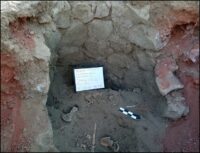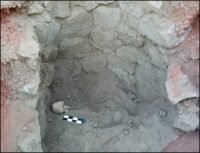 A conical tomb from around 300 B.C. has been discovered in the town of Tepeyahualco, Puebla, southeastern Mexico. Tepeyahualco is four miles south of the archaeological site of Cantona, a pre-Hispanic settlement that was first populated as early as 1000 B.C. and grew into a fortified urban center of regional importance before it was abandoned for unknown reasons around 1050 A.D. This is the first tomb of this type to be discovered outside the five square miles of the Cantona archaeological zone.
A conical tomb from around 300 B.C. has been discovered in the town of Tepeyahualco, Puebla, southeastern Mexico. Tepeyahualco is four miles south of the archaeological site of Cantona, a pre-Hispanic settlement that was first populated as early as 1000 B.C. and grew into a fortified urban center of regional importance before it was abandoned for unknown reasons around 1050 A.D. This is the first tomb of this type to be discovered outside the five square miles of the Cantona archaeological zone.
The tomb was discovered accidentally by residents of Tepeyahualco harvesting volcanic tezontle and basalt rocks for construction. They thought the deceased might be crime victims and called the authorities. An excavation of the site ensued and archaeologists confirmed it was an ancient burial, not a crime scene.
The tomb is 5’2″ high and shaped like truncated cone that narrows to a bottleneck. It is 3’2″ in diameter at the base, widens to 3’7″ in the middle and narrows at the top to 1’6″. The walls are made of local stone that was shaped and polished on the side facing into the tomb while the outside was left in the basalt’s natural form. Fragments of pottery recovered from the tomb are of the Tezontepec Rojo and Payuca Rojo types, which date the burials to the Late Cantona I phase (300 B.C. – 50 A.D.) The shape and materials of the tomb narrow the date town to the Formative period, the earliest part of the Late Cantona I range.
 Unfortunately, because the area has been foraged for building materials for decades, the tomb was damaged and the vault had collapsed. The remains of a second truncated cone tomb were found a few feet away, but it had been completely destroyed by stone harvesting and no skeletal remains were found.
Unfortunately, because the area has been foraged for building materials for decades, the tomb was damaged and the vault had collapsed. The remains of a second truncated cone tomb were found a few feet away, but it had been completely destroyed by stone harvesting and no skeletal remains were found.
The skeletal remains of four young men were found in the first tomb, disarticulated and no longer in their original positions due to the damage. The skull of one the young men had been reshaped in the tabular erect deformation: flattened in the back of the cranium and flattened on the forehead creating a high, bread head shape.
At its peak of expansion (600-900 A.D.), Cantona is estimated to have had a population of around 100,000, but very little is known about the people who lived there during its 2,000 years of occupation because only a tiny fraction of the settlement has been excavated. We know they traded obsidian over a vast network and that it was a ceremonial center for the region, as evinced by the 27 ball game courts found there. Unique among Mexico’s Mesoamerican sites, Cantona is completely asymmetrical in its design. From street grid to squares to pyramids to ball game courts, nothing is repeated, measured or evenly arranged.
The discovery of this system of truncated-conical burials to the south of Cantona, allows us to infer that, from the first phases of occupation of the pre-Hispanic city, its size covered a large area and that its settlers settled in the periphery carried out complex funerary practices, thus as recurrent customs in the American continent since ancient times, such as cranial deformation, the researchers indicated.
The analysis of the surface and the geographical characteristics of the Tepeyahualco region show the abundance of rocky landscape that can host this type of pre-Hispanic burial system, for which its current inhabitants have been participative and concerned about the care of the tomb. and its archaeological heritage, maintaining constant communication with the INAH Puebla Center and organizing itself into brigades, which aim to safeguard its cultural heritage.